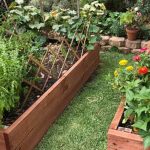Are wood pallets safe for vegetable gardens? In recent years, there has been a growing trend of using wood pallets as a cost-effective and resourceful way to create raised beds and vertical gardens for growing vegetables. This innovative approach to gardening has become increasingly popular among urban gardeners, DIY enthusiasts, and environmentally conscious individuals. However, the safety of using wood pallets in vegetable gardens has sparked some debate and raised concerns among gardening enthusiasts.
Using wood pallets in vegetable gardens offers several benefits, from providing an affordable and sustainable gardening solution to allowing for easy mobility and customization. Many gardeners appreciate the versatility and rustic charm that wood pallets bring to their outdoor spaces. However, it is essential to address the potential risks and safety issues associated with repurposing these wooden structures for gardening purposes.
In this article, we will explore the advantages of using wood pallets in vegetable gardens, as well as the potential safety concerns that come with it. We will also provide valuable tips on how to select safe and untreated wood pallets for your garden, prepare them for use, and maintain their longevity.
Whether you are a seasoned gardener or new to the world of urban farming, this guide will help you make informed decisions about incorporating wood pallets into your vegetable garden while prioritizing safety.
Benefits of Using Wood Pallets in Vegetable Gardens
Wood pallets are becoming an increasingly popular choice for vegetable gardening due to their affordability and versatility. There are several benefits to using wood pallets in your vegetable garden that make them an attractive option for both experienced and novice gardeners.
Optimal Use of Space
One of the major advantages of utilizing wood pallets in vegetable gardens is their ability to maximize space. By using vertical gardening techniques, such as stacking and hanging pallets, gardeners can grow a variety of vegetables without taking up a large footprint. This is particularly beneficial for urban or small-space gardeners who have limited room for traditional gardens.
Eco-Friendly Solution
Wood pallets are often favored by environmentally conscious gardeners because they can be repurposed or upcycled. Using wood pallets for gardening reduces the need for new materials, thereby decreasing environmental impact. Additionally, as they age, wood pallets can break down and contribute to the overall health of the soil in the garden.
Customizable and Portable
Wood pallets offer a great deal of flexibility in terms of design and arrangement. Gardeners can easily customize their wooden pallet structure to fit their specific gardening needs, whether it’s creating raised beds or dividing sections for different types of vegetables. Furthermore, wood pallets are typically light enough to be moved around the garden as needed, allowing for easy reconfiguration if necessary.
These advantages demonstrate that wood pallets can be a practical and beneficial option for growing vegetables in a sustainable manner. However, it’s important to address potential safety issues and risks associated with using wood pallets in vegetable gardens before incorporating them into your gardening practice.
Risks and Concerns
Wood pallets have become increasingly popular for gardening due to their affordability, versatility, and sustainability. However, there are concerns about the safety of using wood pallets in vegetable gardens. These concerns mainly revolve around the potential for harmful chemicals and contaminants in the wood that could leach into the soil and affect the vegetables.
One of the primary safety concerns when using wood pallets for vegetable gardens is the possibility of chemical contamination from treatments and preservatives used on the wood. Wood pallets are often treated with hazardous chemicals such as methyl bromide, a pesticide used to kill pests and fungi. These chemicals can leach into the soil over time and pose a risk to both human health and plant growth.
In addition to chemical treatments, there is also a risk of contamination from other sources such as spills or transportation-related pollutants that may have come into contact with the wood. It is important for gardeners to be aware of these potential risks and take proactive steps to mitigate them in order to ensure the safety of their vegetable gardens. Many gardeners wonder if they should use these types of materials: are wood pallets safe for vegetable gardens?
| Wood Pallet Safety Concerns | How to Address |
|---|---|
| Chemical treatments | Choose untreated or heat-treated pallets |
| Contamination from spills or transportation | Inspect pallets thoroughly and clean before use |
| Potential for mold or bacteria growth | Proper preparation and ventilation of pallets before use |
Choosing the Right Wood Pallets
When it comes to using wood pallets for vegetable gardens, it is crucial to prioritize safety and ensure that the materials you are using are free from harmful chemicals or treatments that could potentially leach into the soil and affect your plants. Here are some tips on how to choose the right wood pallets for your garden:
- Look for pallets that are labeled with the initials “HT,” which stands for heat treated. Heat treated pallets undergo a heating process to eliminate pests and pathogens, making them a safer option for gardening.
- Avoid pallets that are marked with “MB,” which indicates that they have been treated with methyl bromide, a toxic chemical used as a pesticide. These pallets should be avoided at all costs due to the potential health risks they pose.
- Inspect the pallets for any visible signs of damage or spills. Avoid using pallets that appear to be heavily stained, as these may indicate previous chemical spills or contamination.
It is important to note that not all wood pallets are suitable for use in vegetable gardens, and selecting the right ones can make a significant difference in the safety and success of your garden. By being mindful of the type of wood pallets you choose, you can create a healthy and sustainable environment for your plants to thrive.
In addition to these tips, you can also consider reaching out to local businesses or recycling centers to inquire about obtaining untreated wood pallets for your garden. Many companies are willing to part with their used pallets, giving you access to safe materials while also reducing waste. By putting in the effort to select safe and untreated wood pallets, you can enjoy all the benefits of using this versatile material in your vegetable garden without compromising on safety.
Preparing Wood Pallets for Use
Wood pallets can be a great, cost-effective way to create raised beds for vegetable gardens, but it is crucial to ensure that the pallets are safe for use in growing edible plants. Here is a step-by-step guide on how to prepare wood pallets for gardening to ensure safety:
1. Choose the Right Pallet: When selecting wood pallets for your vegetable garden, it is important to choose untreated or heat-treated pallets. Avoid using pallets that have been treated with chemicals or pesticides, as these can leach into the soil and potentially harmful to your plants.
2. Inspect the Pallet: Before using a wood pallet for gardening, carefully inspect it for any signs of damage or contamination. Look out for stains, discoloration, or mold that may indicate chemical residues or contaminants. Check for any loose nails or splinters that could pose a safety hazard.
3. Clean and Sand the Pallet: Once you have selected a safe wood pallet, clean it thoroughly with water and a mild soap to remove any dirt and debris. After cleaning, sand down the surface of the pallet to smooth out any rough edges or splinters. This will help prevent any potential injury while working with the pallet and ensure that it does not cause harm to your plants.
By following these steps and taking proper precautions, you can safely prepare wood pallets for use in your vegetable garden. Remember that choosing safe and untreated wood pallets is essential in ensuring the health of your plants and ultimately, your own well-being when consuming the produce from your garden. Use this guide as a reference when preparing wood pallets for gardening to ensure safety.
Creative Ways to Use Wood Pallets in Vegetable Gardens
Wood pallets are incredibly versatile and can be used in numerous creative ways in vegetable gardens. One of the most popular DIY projects involving wood pallets is creating a vertical garden. This is especially beneficial for small spaces as it allows you to maximize vertical space for growing vegetables. By attaching pots or planters to the slats of the pallet, you can create a stunning and functional garden feature.
Another creative way to use wood pallets in vegetable gardens is to repurpose them as raised beds. By standing the pallet on its end and filling it with soil, you can create a convenient and affordable raised bed for your vegetables. This not only adds visual interest to your garden but also helps with weed control and makes gardening more accessible by reducing the need for bending and kneeling.
In addition, wood pallets can also be transformed into compost bins, trellises, or even storage solutions for garden tools. The possibilities are endless when it comes to utilizing wood pallets in vegetable gardens, making them an eco-friendly and cost-effective alternative for gardeners.
| Creative Ways to Use Wood Pallets | Benefits |
|---|---|
| Vertical garden | Maximizes vertical space |
| Raised beds | Helps with weed control and accessibility |
| Compost bins, trellises, or storage solutions | Offers various other functionalities |
Maintenance and Upkeep
Maintaining and prolonging the life of wood pallets in vegetable gardens is essential to ensure the health and safety of your plants. Here are some important tips to consider for maintaining and caring for your wood pallets:
Regular Cleaning and Inspection
It’s crucial to regularly clean and inspect your wood pallets to prevent any potential hazards or damage. Use a brush or pressure washer to remove dirt, debris, and any chemical residue from previous use. Inspect the pallets for signs of rot, mold, insect infestation, or structural damage. Address any issues immediately to avoid compromising the safety of your vegetable garden.
Applying Protective Sealant
To extend the lifespan of your wood pallets, consider applying a protective sealant or stain. This will help protect the wood from weathering, moisture, and UV damage. Look for non-toxic sealants that are safe for use in vegetable gardens. Apply the sealant according to the manufacturer’s instructions and reapply as needed to maintain protection.
Proper Storage
When not in use, store your wood pallets in a dry and well-ventilated area. Excessive exposure to moisture can lead to decay and deterioration of the wood. Storing the pallets off the ground on blocks or pallet racks can also help prevent moisture absorption from the ground.
By following these maintenance tips, you can ensure that your wood pallets remain safe and durable for use in your vegetable garden. Proper care and attention will not only prolong their lifespan but also contribute to a healthy growing environment for your plants.
Conclusion
In conclusion, wood pallets can be a safe and cost-effective option for gardening, as long as certain precautions are taken. The rising trend of using wood pallets for vegetable gardens is understandable, considering the benefits they offer. They are versatile, easy to find, and can be repurposed into various DIY projects for gardeners. However, it is important to address the potential risks and concerns associated with using wood pallets for gardening.
One of the main concerns with using wood pallets in vegetable gardens is the potential presence of harmful chemicals or contaminants. To ensure safety, it is crucial to choose the right type of wood pallets and properly prepare them for use in the garden. Selecting untreated and heat-treated wood pallets is essential to minimize any risk of chemical exposure to your plants and soil.
Ultimately, when choosing to use wood pallets in your vegetable garden, it is important to prioritize safety and take necessary steps to mitigate any potential risks. By selecting safe and untreated wood pallets, properly preparing them for use, and regularly maintaining them, you can enjoy the benefits of using wood pallets while keeping your vegetable garden safe and healthy.
With proper care and attention, wood pallets can indeed be a safe option for gardening enthusiasts looking to get creative in their vegetable gardens.
Frequently Asked Questions
Do Pallets Leach Chemicals Into Soil?
Pallets can leach chemicals into the soil, especially if they have been treated with toxic substances. This can be a concern for gardeners growing food in pallet gardens, as the chemicals can contaminate the vegetables.
How Do You Tell if Wood Pallets Are Chemically Treated?
One way to tell if wood pallets are chemically treated is by looking for an IPPC stamp. If the stamp includes “HT,” it means the pallet has been heat treated, which is safe for gardening. However, if it includes “MB,” it means the pallet has been fumigated with methyl bromide and should be avoided for gardening use.
What Vegetables Grow Well in a Pallet Garden?
Several vegetables grow well in a pallet garden, including lettuce, spinach, kale, tomatoes, peppers, cucumbers, and herbs like basil and parsley. These plants are suitable for the shallow depth of a pallet garden and can thrive in confined spaces.

If you’re looking to get into vegetable gardening, or are just looking for some tips on how to make your current garden better, then you’ve come to the right place! My name is Ethel and I have been gardening for years. In this blog, I’m going to share with you some of my best tips on how to create a successful vegetable garden.





